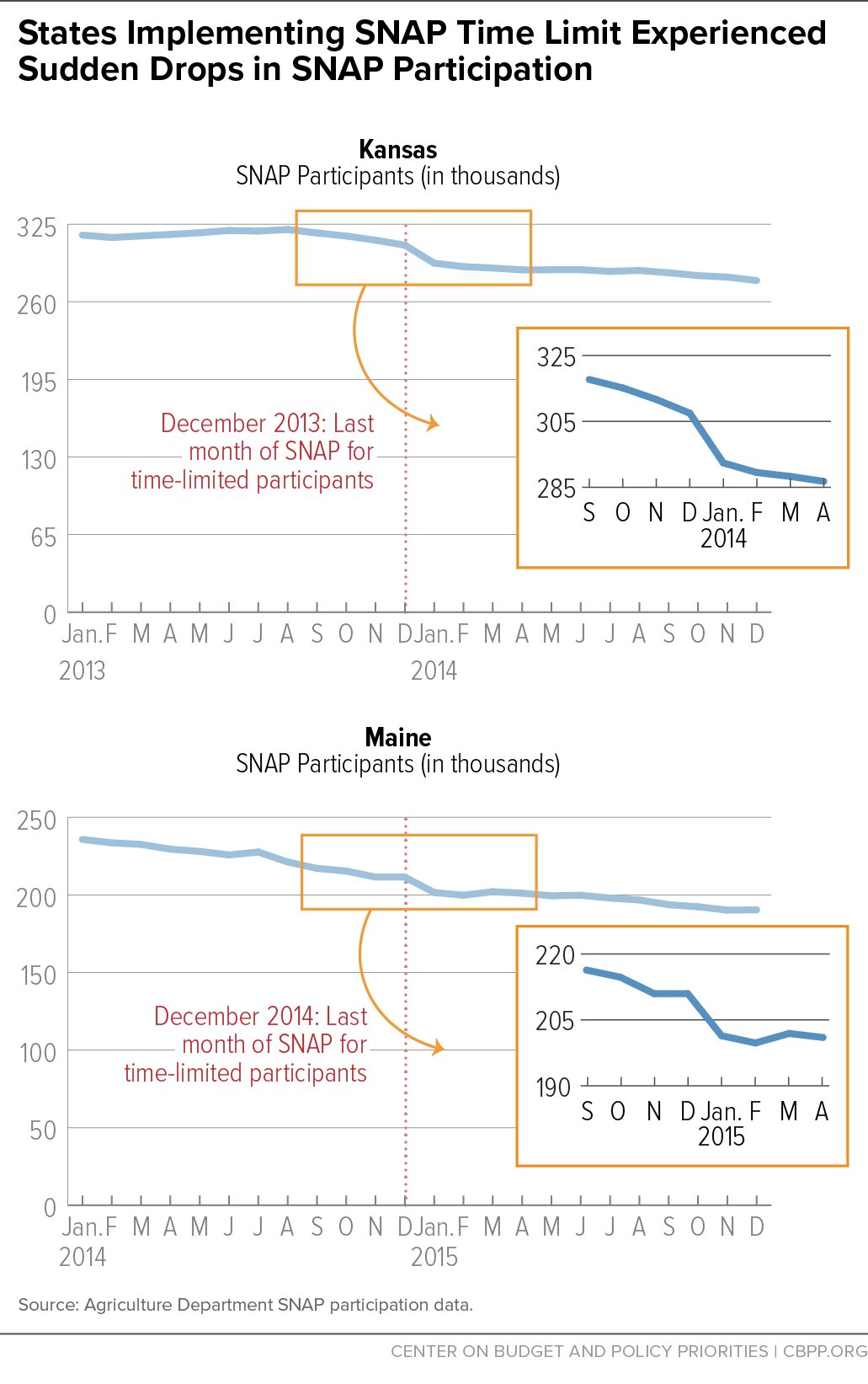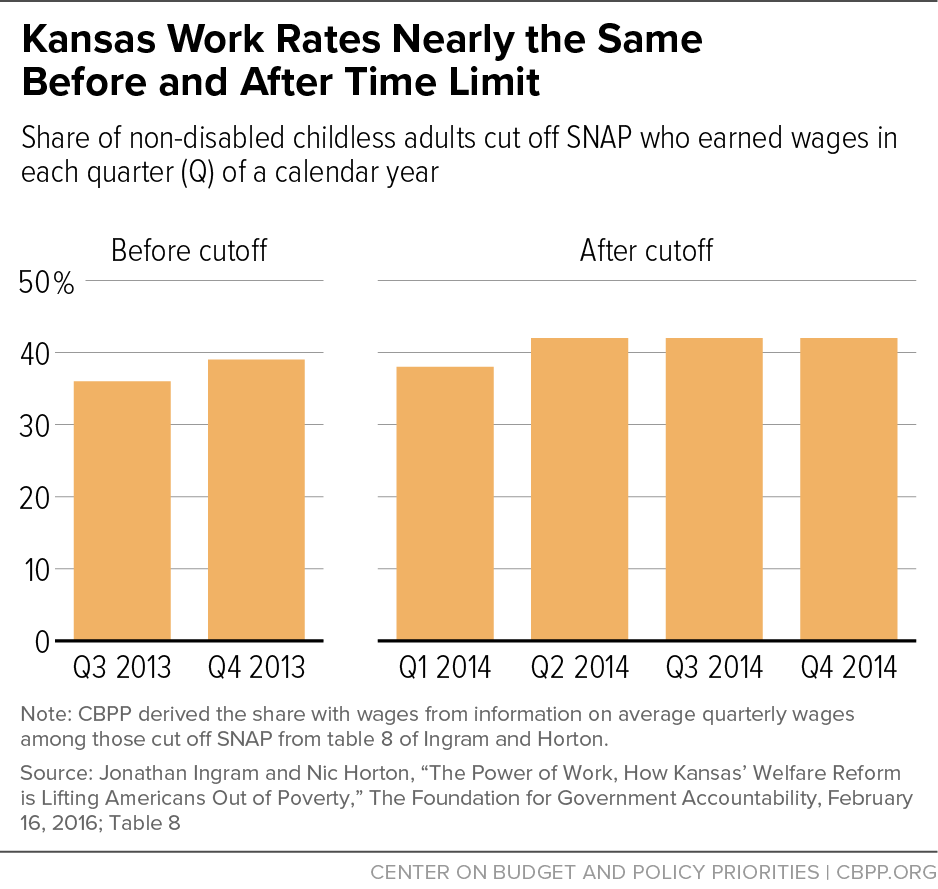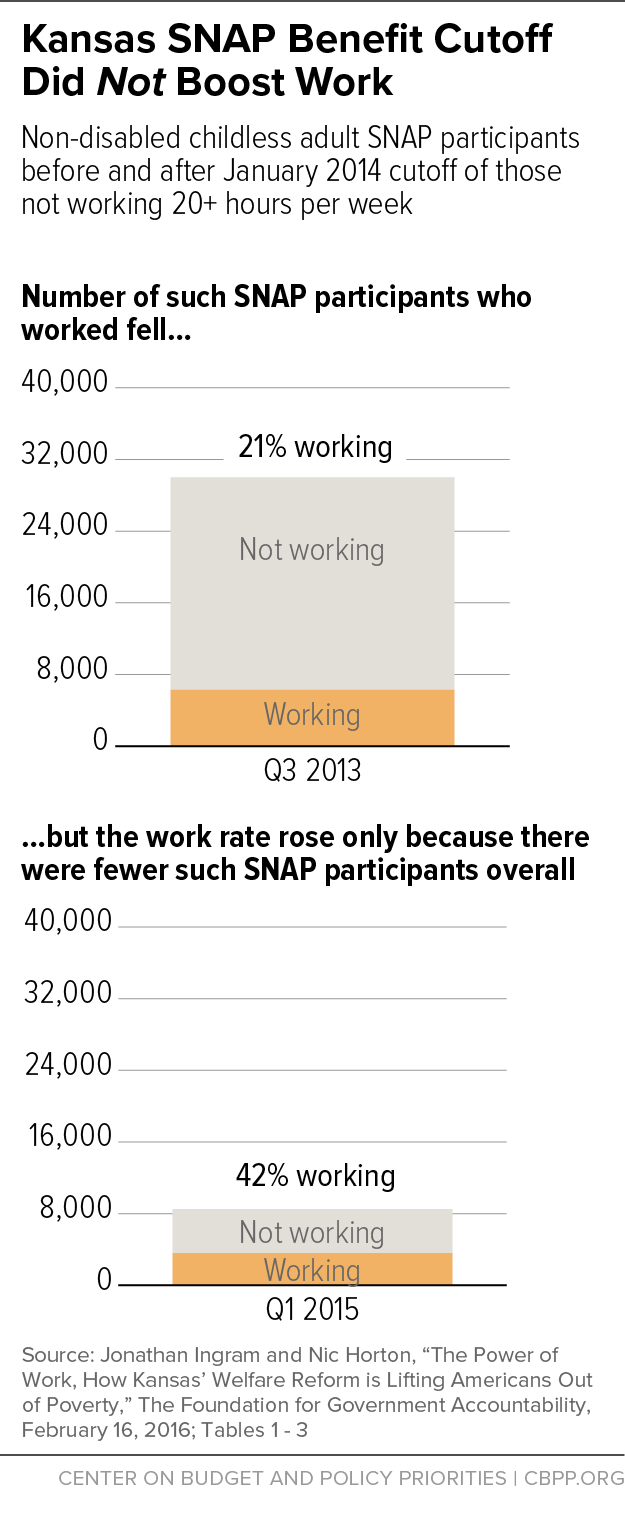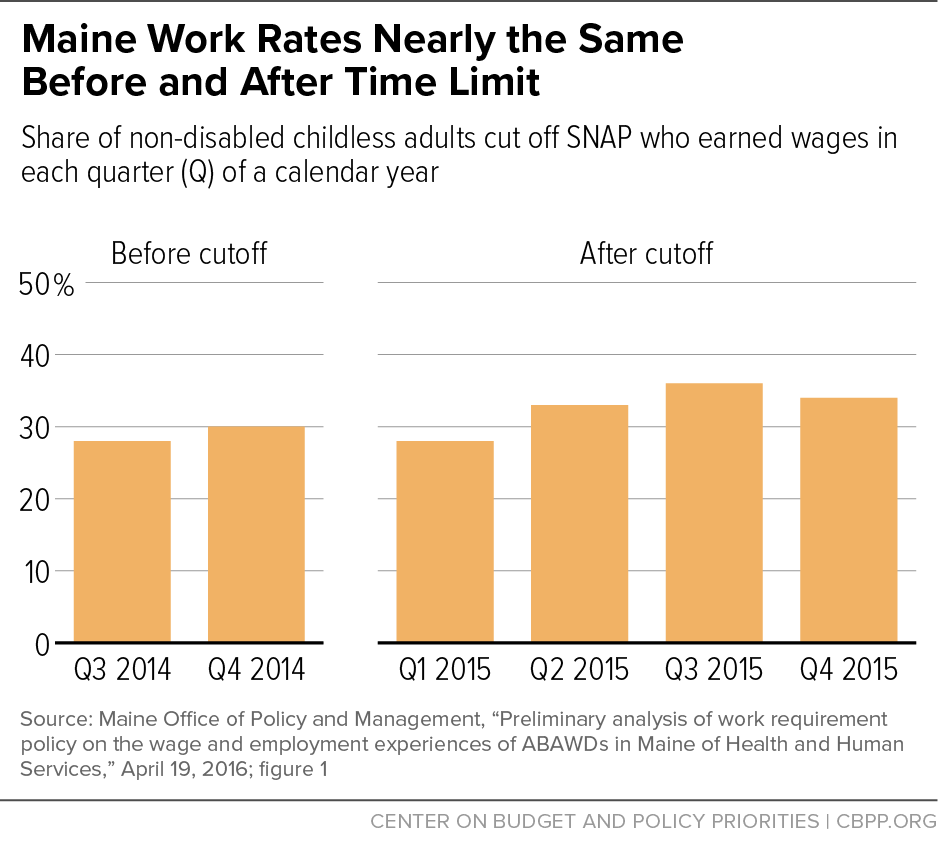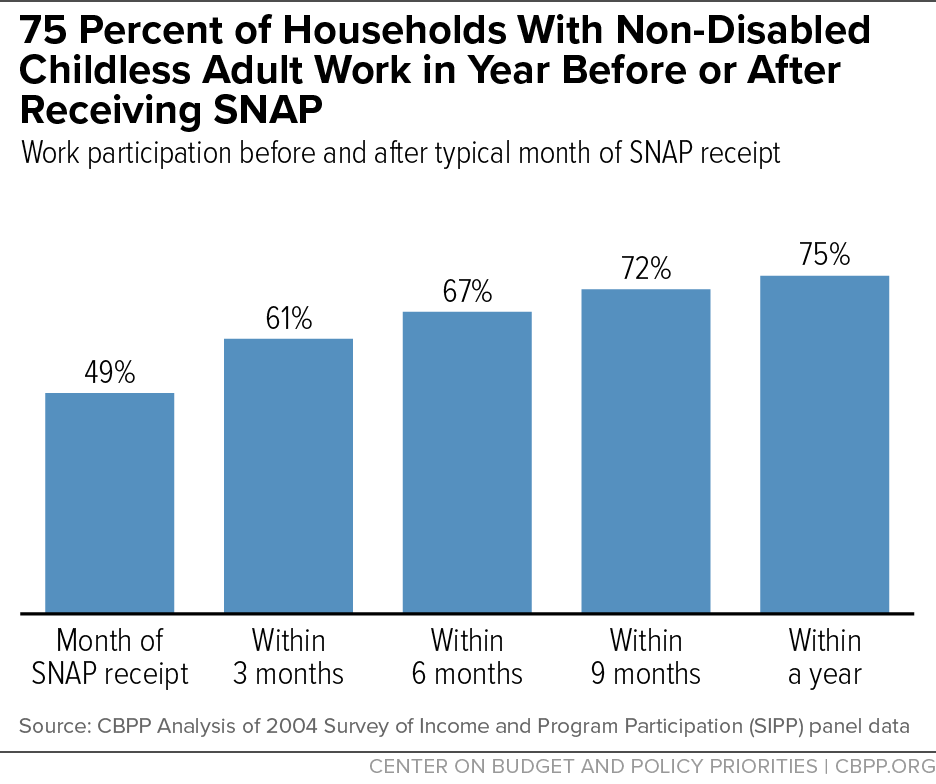Two reports this year, citing data from Kansas and Maine, have touted the alleged success of reimposing a three-month time limit on SNAP participation for childless adults.[1] The reports assert that, as a result of the SNAP time limit, work rates and wages have increased dramatically and the individuals subject to the time limit are better off. The reports, however, misrepresent or omit data and, as a result, make claims about the impact of the time limit on work and earnings that the facts do not support. The analyses also rest on faulty assumptions about why some childless adults receiving SNAP are not working.
The reports’ three largest problems are:
- They do not take into account that many SNAP recipients already work, or would work soon even without the time limit. The studies attribute rising work rates and earnings to the return of the time limit even though most, if not all, of the changes would have happened without it. The authors fail to acknowledge that many SNAP recipients who are subject to the time limit were working already, or would soon be working, and as a result, their work rates and wages would likely have risen without the time limit. They make claims that can only be identified through a rigorous evaluation that isolates the impacts of the time limit from what would have happened without it (see box below). Such an approach is underway to test a range of approaches to SNAP employment and training in ten states, including Kansas.
- They do not consider the potentially severe impact of the time limit on those cut off SNAP. The studies fail to discuss the circumstances of the individuals who are subject to the time limit and the consequences for increased hardship and food insecurity when they lose SNAP benefits. Without addressing this side of the equation, the studies misrepresent the effect of reinstating the time limit on the well-being of those cut off SNAP. Their figures on the average income of those cut off SNAP are highly misleading because they do not include the loss of SNAP benefits. They do not discuss or attempt to assess what happens to individuals who lose their food assistance and are unable to find employment, who are a large share of those cut off.
- They do not adequately consider the likely explanations for why childless SNAP participants may not work. The authors advance the theory that individuals are avoiding work and remaining in poverty in order to qualify for modest SNAP benefits of only about $5 a day. But research and experience in states with the time limit in effect offer evidence of alternative explanations. Many such individuals do work when they can, but they often face significant barriers to work, such as low education and skills or physical or mental health issues.
A careful look at the data presented in the reports, taking these factors into account, strongly suggests that not much changed related to work and earnings when the time limit took effect, but the time limit did cause thousands of the states’ poorest residents to lose essential SNAP benefits. Policymakers and the public should be careful not to draw the wrong conclusions about the impact of the time limit on work, earnings, and recipients’ well-being based on these problematic reports.
Childless adults on SNAP are extremely poor. Like adults with children, childless adults often turn to SNAP for assistance when they are no longer able to make ends meet, especially as they lose jobs, their hours are cut, or their wages hover at the federal minimum. While participating in SNAP, their income averages 29 percent of the poverty line, the equivalent of about $3,400 per year for a single person in 2016. About half (46 percent) live in households that have any income in the months they are receiving SNAP.[2]
One of the harshest provisions of the 1996 welfare law limits many childless adults to three months of SNAP benefits in any 36-month period when they aren’t employed at least half-time or in a qualifying work or training program. In setting this limit, the welfare law didn’t require states to offer work or job training to people who were unable to find a job on their own; nor did it provide funds to states for that purpose. And in reality, most states don’t offer these programs.
SNAP recipients in a state that fails to offer them a spot in a work or training program — which is the case in most states — have their benefits cut off after three months even if they are searching diligently for a job or working less than 20 hours a week.
Because this provision denies basic food assistance to people even if they want to work and would accept any job or work program slot offered, it is effectively a severe time limit rather than a work requirement, as such requirements are commonly understood. Work requirements in public assistance programs typically require people to look for work and accept any job or employment program slot that’s offered. But they don’t cut off people who are willing to work and looking for a job simply because they can’t find one.
Given that the time limit could be unduly harsh in areas where job openings didn’t exist, the 1996 welfare law gave states the option to request that the time limit be waived in areas with high unemployment. Prior to the recession, that resulted in the time limit operating in about two-thirds of the country (and not in effect in one-third of the country that represented areas with a lack of jobs). When the recession decimated the labor market and unemployment spiked, most states, including Kansas and Maine, requested the time limit be waived statewide. Kansas reimposed the time limit statewide beginning in October 2013 and Maine reinstated the time limit statewide in October 2014, even though both states qualified for a statewide waiver at the time the time limit returned.
In both states total SNAP caseloads already were declining, but they dropped significantly four months after the time limit was put in place, as Figure 1 shows. Data from Kansas and Maine that are limited to the childless adults who were potentially subject to the time limit show that SNAP participation fell among that group by 70 to 80 percent after the time limit returned.
As unemployment rates have fallen in recent years, most states have been able to waive only high-unemployment areas within the state, or, like Kansas and Maine, have opted to forgo waivers altogether. More than 40 states implemented the time limit in 2016, 22 for the first time since before the recession.[3] We estimate that as a result of the reimposition of time limits, at least 500,000 childless adults lost SNAP over the course of 2016.[4]
One of the central tenets of sound, evidence-based research is the need to have a “comparison group” so that the results can properly account for what would have happened in the absence of a change.
For example, consider researchers who are testing the efficacy of a new medicine designed to speed recovery from the common cold. The researchers would need to know how fast people would have gotten better without the medicine. Without a comparison group there would be no way to know what to make of results that showed, for example, that 30 percent were better after two days and 85 percent were better after five days. Many, perhaps all, of these people would have gotten better without the medicine.
The gold standard for comparison groups is “random assignment,” an experimental approach where people who are otherwise the same are randomly assigned to different “treatment” groups and the effects of the change are measured on each group so the study can isolate the effect of the “treatment.” These types of studies are expensive, though some are underway in SNAP.
In the case of low-income childless adults, two important factors are critical for interpreting the information in the Kansas and Maine reports. First, many low-skill, low-wage workers do work, but they work in high-turnover jobs with low job security and often experience sporadic employment. SNAP acts as a safety net, providing assistance during periods of unemployment or when work hours are cut. It is common for SNAP recipients to have higher employment and wages in the future. Second, both Kansas’ and Maine’s economies were improving between 2013 and 2015, the period in which the two states implemented the time limit and purport to measure the results. Without controlling for these factors, it is difficult to isolate the effects of the time limit on employment.
The authors of the reports for Kansas and Maine could have established less complicated and less costly alternative “comparison groups” by conducting the same analysis in the year before the cutoff to observe the work rates and earnings for similar SNAP recipients during a period when the time limit was not in effect. Such an approach would not have been perfect — it would be impossible to take the differences in the labor market and all other factors into account — but it would have been a more informative comparison than these reports provide.
The studies from Kansas and Maine assert that reimposition of the time limit resulted in higher work rates and earnings for individuals who lost SNAP benefits after exhausting three months of eligibility.
- For Kansas, the authors claim, “These reforms immediately freed nearly 13,000 Kansans from welfare on December 31, 2013. Nearly 60 percent of those leaving food stamps found employment within 12 months and their incomes rose by an average of 127 percent per year.”[5]
- For Maine, the Department of Health and Human Services’ press release reported that among the individuals whose SNAP was cut off, “Incomes rose 114 percent within a year of leaving the program,” and “nearly half (48%) worked at least one quarter in 2015.”
These reports, however, dramatically overstate the increase in work rates and wages that resulted from the reimposition of the time limit because many of the SNAP recipients affected were working, or would have started working anyway, albeit mostly in low-wage jobs with high turnover. Moreover, both states reimposed the time limit when their unemployment rates were dropping and unemployed individuals were somewhat more likely to be able to find work or higher wages as a result.[6]
The authors of the Kansas report overstate the degree to which work rates increased after the time limit and misrepresent the effect of the time limit on numerous outcomes for SNAP recipients while they are receiving SNAP.
The Kansas authors claim that “nearly 60 percent of those leaving [SNAP after the three-month time limit went into effect] found employment within 12 months.” (The authors’ estimate of 60 percent is the share who had ever worked in any quarter of 2014.) The claim implies that the policy change reimposing the time limit was the reason that these people found work, but it’s misleading, as explained below.
However, work rates before and after the time limit were very similar, as Figure 2 shows. Almost 40 percent of those whose SNAP was cut off already worked in each of the last two quarters before the time limit returned (the third and fourth quarters of 2013).[7] The share working each quarter in the year after the time limit was implemented rose slightly, to just over 40 percent. This modest increase could be explained by two factors: (1) low-wage workers are more likely to apply for and participate in SNAP when they lose a job or their incomes drop, so they often experience improvements in the future as their employment situation improves; and (2) Kansas’ economy was improving over 2014, so a slightly larger share of recipients may have been able to find jobs or higher pay. The time limit does not appear to have dramatically affected work rates for the group subject to it.
The authors, however, reached the opposite conclusion — that work rates grew significantly after the time limit returned. Instead of comparing the average work rates in each quarter for this population before and after the policy change, they report the share of individuals whose SNAP was ended after December 2013 who ever worked in a quarter over the following year. This captures typical movement in and out of the labor force — given that this group tends to work in high-turnover jobs, in any quarter some people lose jobs and some get new jobs, so the share that ever worked increases — rather than an isolated impact of the policy change. The trends in the share who ever worked likely followed a very similar pattern in earlier years when the time limit was not in effect (though the authors do not present such data). As discussed below, other research about labor force participation among childless adults who receive SNAP finds work rates over time similar to those in the Kansas report.
The Kansas report presents highly misleading information about other changes among individuals subject to the time limit who receive SNAP. For example:
[S]ince restoring work requirements, the employment rate among able-bodied adults on food stamps has doubled. As a result their incomes have more than doubled on average, they are spending less time on welfare, and the need for assistance has significantly declined.[8]
These claims, which the report makes across a range of measures, are misleading because the childless adults who remained as SNAP participants after the time limit went into effect were significantly different from those who participated before because of the policy change. The state cut off SNAP those participants who were not working at least 20 hours a week, so the work rates, average earnings, and other characteristics of those who remained SNAP participants after the return of the time limit were better, not because those individuals became better off, but because they were better off to begin with and were the only ones still eligible and participating in SNAP.
Those who may still participate in SNAP are more likely to have earnings and, as a result, lower SNAP benefits and appear better off on a range of other characteristics. In fact, the number of childless adult SNAP recipients working at least 20 hours a week, and thus the only non-exempt childless adult SNAP recipients eligible for the program, dropped modestly in the year after the time limit took effect.[9]
As an example of this misleading representation, consider the authors’ assertion that, “[p]rior to restoring work requirements, just 21 percent of childless adults on food stamps were working at all. Two-fifths were working less than 20 hours per week. But since work requirements have gone back into effect, that employment rate has risen to nearly 43 percent.”[10] The change was driven by a drop in the number of SNAP recipients who are childless adults subject to the time limit, not an increase in the number of recipients who are working. The number of such SNAP recipients who were working fell by more than 40 percent (from 6,300 to 3,600), as those who were working less than 20 hours a week were cut off, while the total number of non-disabled childless adults receiving SNAP dropped by more than 70 percent (from almost 30,000 to 8,500). (See Figure 3.)
Maine Also Inappropriately Attributes Changes to the Policy Change That Likely Would Have Occurred Anyway
Maine’s data on work rates and wages among individuals who lost SNAP are similar in magnitude to Kansas, and, as in the Kansas report, the authors of the Maine report and the accompanying materials from the Department of Health and Human Services overstate the impact of the time limit by failing to take into account the fact that changes would have occurred even without it.
As Figure 4 shows, before the reimposition of the time limit in October 2014, about 30 percent of the childless adults whose SNAP was cut off were working. That proportion peaked in the months after the time limit went back into effect at 36 percent in the third quarter (the summer, a time when employment in Maine tends to be higher). But, though the report includes these quarterly rates, like for Kansas, the Maine report and accompanying materials emphasize a different figure: that 48 percent had wages some time in 2015 and 58 percent had wages at some time ever in 2014 or 2015. But again, like for Kansas, the higher numbers count any time anyone had worked in any quarter, and thus largely reflect employment instability at a time that the state’s economy was improving, rather than a change that could be attributed to the reimposition of the time limit.
The one-sided pictures in these reports fail to discuss the well-being of the individuals whose SNAP benefits were cut off. But research suggests that many childless adults who lose SNAP as a result of the time limit continue to struggle after losing SNAP, in contrast to the reports’ portrayals of circumstances for recipients who lost benefits. The most comprehensive assessment of former SNAP recipients in four states in the early 2000s suggests that their life circumstances are quite difficult. A significant minority don’t find work, and among those who are employed after leaving SNAP, earnings are low. Most remain poor. Many struggle to acquire enough food to meet their needs, lack health insurance, experience housing problems, and/or have trouble paying their bills.[11]
In a serious omission the Kansas and Maine reports do not consider the impact of the time limit on the large number of people who lost SNAP and are among the nation’s very poorest adults.
- In Kansas the number of non-disabled childless adults receiving SNAP dropped by 75 percent (from about 30,000 in late 2013 to about 7,500 in late 2015).
- The Maine report does not present comparable numbers, but an earlier Heritage Foundation report cited Maine Department of Health and Human Services data showing that the number of “able-bodied adults without dependents on food stamps” dropped by 80 percent (from about 13,300 in late 2014 to 2,700 in March 2015).[12]
The individuals whose SNAP was cut off lost about $5 a day, or $150 to $170 per person per month in SNAP benefits for purchasing food. Many of them worked in the year after losing benefits, but for some their wages were low enough that they could have continued to qualify for SNAP benefits, which could have helped them make ends meet. Some others with no earnings for some or all of the subsequent year may have had virtually no resources available for food after they were cut off SNAP.
The Kansas and Maine reports cite average income figures for the year after recipients lost SNAP, but they fail to account for the lost SNAP benefits. To accurately compare income for a household that used to be on SNAP to income after losing SNAP, the lost value of the SNAP benefits must be included. When they are accounted for, total income does not increase substantially (or actually decreases slightly).
In Kansas, the authors rest their claim that SNAP recipients were better off after the cutoff on a point that the group’s income rose by 127 percent between before the time limit took effect and one year later. There are three problems with this claim:
- First, as discussed above, it implies that the time limit was responsible for the earnings increase, when most, if not all, of it likely would have occurred anyway;
- Second, it excludes the value of SNAP benefits from the calculation. Total resources available to the household were higher before the time limit because the household received SNAP benefits; and,
- Third, the authors picked a low comparison quarter prior to the time limit returning to exaggerate the increase — wages for the group cut off were more than 30 percent lower two quarters before the cutoff (3rd quarter of 2013, the quarter used in the report) than they were in the quarter immediately preceding the cutoff (the 4th quarter of 2013). They do not explain why they chose this particular quarter as the baseline.
It is not possible to adjust for the first issue without a rigorous evaluation (see box), but even adjusting only for the other two issues makes a large difference. If $178 a month in SNAP benefits (the average SNAP benefit among those cut off in December 2013) is included in the base period, and if we compare the quarter immediately before the cutoff (the 4th quarter of 2013) as the base period instead of the quarter earlier, the total resources (including earnings and SNAP benefits) available to SNAP participants who were cut off was 3 percent lower a year after the cutoff, rather than 127 percent higher.
Had the SNAP recipients who remained income-eligible been able to keep receiving SNAP (rather than being cut off by the time limit) more of them would be better off because they could have received SNAP while working (though their SNAP benefits would be lower because income counts in determining SNAP benefit levels).
A similar contrast applies to the Maine report. The press release that accompanied the report claims that total income for those cut off rose by 114 percent within a year. However, if the state had included the value of SNAP benefits in the base, the increase would be much smaller — only about 10 to 20 percent.[13]
If a better picture of the data shows that the time limit doesn’t have a strong role getting people into work, what do we know about why this group struggles to find employment? The little research that exists on this population shows that childless adults work when they can, but often in jobs with high turnover and low job security, and most struggle with multiple barriers to employment.
Childless adults on SNAP work when they can.[14] However, the work tends to be low-wage and unstable, with individuals cycling through periods of work and unemployment. At least a quarter of households with childless adults work while receiving SNAP, and about 75 percent work in the year before or the year after receiving SNAP.[15] (See Figure 5.) Limited education, lack of training, and a sporadic work history make it difficult to compete for anything other than low-skill, low-wage jobs that do not lift them out of poverty.
Childless adults on SNAP face barriers. Many low-income childless adults face multiple challenges to independence and self-sufficiency, including homelessness, physical and mental health limitations, language barriers, unstable employment histories, and criminal records. A detailed study of childless adults who were referred to a work experience program in Franklin County (Columbus), Ohio found that:[16]
- Many have extremely unstable living situations, illustrated by residence in short-term shelters or with friends and family and limited telephone service.
- One-third have a mental or physical limitation, including depression, post-traumatic stress disorder, mental or learning disabilities, or physical injuries. Some of these disabilities, though not severe enough to qualify for federal disability benefits, may still limit a person’s ability to work at least 20 hours a week.
- About a quarter have less than a high school education, and more than half have only a high school diploma or GED.
- Nearly one-quarter are non-custodial parents, and 13 percent are caregivers for a parent, relative, or friend.
- More than 40 percent lack access to reliable private or public transportation; 60 percent lack a valid driver’s license.
- Fifteen percent need supportive services like language interpretation or help with transportation to obtain employment.
- More than one-third have felony convictions, making it hard to find jobs and pass background checks.
Despite the fact that SNAP has long had an Employment and Training component and all states operate related programs for SNAP recipients, there is little research evidence about what works to improve SNAP recipients’ employment and earnings. As a result, the 2014 farm bill, on a bipartisan basis, authorized and funded pilots in ten states, including Kansas, to expand their existing SNAP employment and training services to test innovative employment and training strategies. The pilots are underway and include a rigorous, independent evaluation (including randomly assigned comparison groups) that will examine the effects of the states’ efforts on unsubsidized employment, earnings, and other factors, such as receipt of public assistance. Kansas is testing “intensive case management followed by career pathways training and work-based learning opportunities.”[17]
Rigorous research in the Temporary Assistance for Needy Families (TANF) program, which provides cash assistance and other services primarily for low-income families with children, has not found significant long-term positive effects of work requirements compared to what occurs in the policies’ absence. The evidence from studies conducted in the context of TANF before and after the 1996 welfare law shows that their effects were modest and faded over time, and they did little to reduce poverty.[18] These findings reinforce that the claims made in the Kansas and Maine reports would not stand up to scrutiny if a random assignment approach had been used to isolate the effects of the time limit.
Poor childless adults turn to SNAP when they lose a job or their lack of income jeopardizes their ability to feed themselves. This is in line with SNAP’s stated goals and purposes. Many childless adults who receive SNAP lack the basic education, training, or work experience necessary to find a job. Yet, the evidence shows that many of those who are able to work do work, both while on SNAP and before and after participating.
The reports claiming that terminating SNAP after three months for this population in Kansas and Maine resulted in increased work rates misleadingly present only what happened after the time limit took effect. The reports fail to consider that many SNAP recipients already worked, or would work soon even without the time limit. Looking at the same population before the time limit took effect reveals similar work rates. While challenges exist in getting unemployed childless adults back into the workforce, there’s no evidence that the time limit itself has a significant effect on work. Increasing work among childless adults is likely to require addressing the significant barriers to work that they face.
Despite their claims, the reports about the experience in Kansas and Maine do not provide persuasive evidence that reimposing the SNAP three-month time limit increases work effort or well-being among childless adults. Policymakers should not draw conclusions about the time limit based on these faulty assessments of the data.
